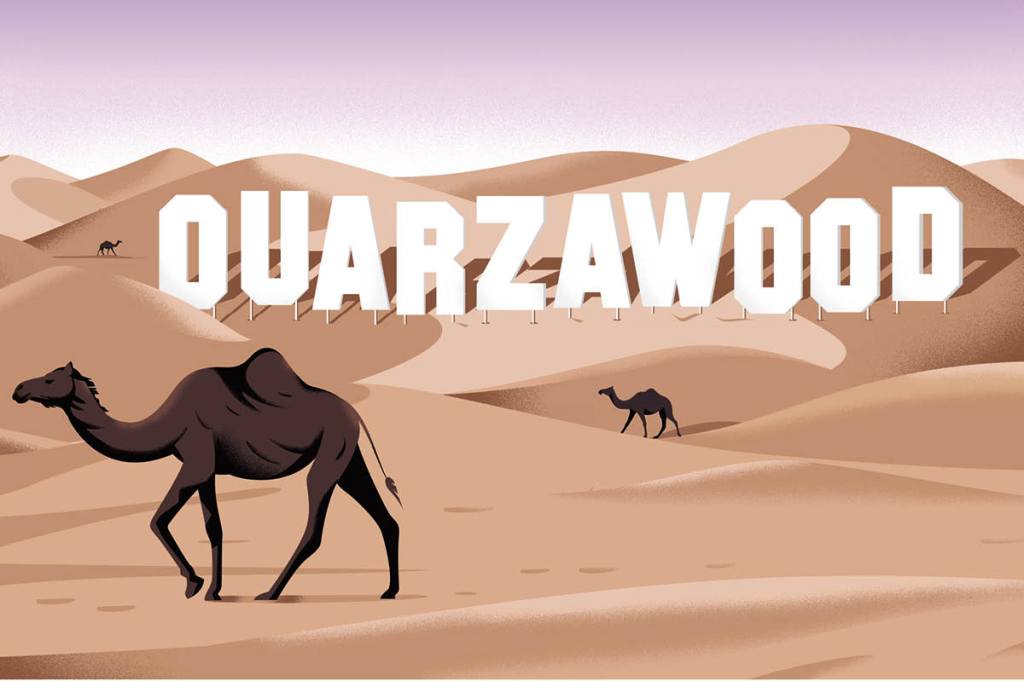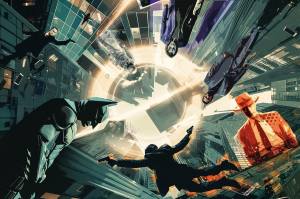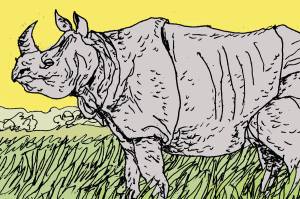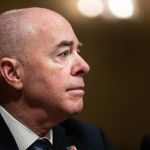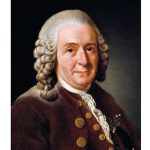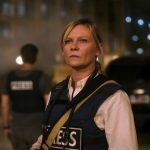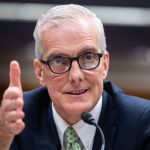It’s been a nearly seven-hour drive up and down the Atlas Mountains from Marrakech before a roundabout appears at the entrance to Ouarzazate, the Amazigh (Berber) outpost where we might be able to stave off hunger, thirst and fatigue. But first, follow that roundabout — the one featuring a gigantic director’s clipboard. Then turn left and enter the parking lot of the Atlas Studios, known to the outside world as Ouarzawood, the must-see largest studio in the Sahel, just 230 miles from Merzouga: the gateway to the Sahara.
Park before a half-dozen faux Egyptian Ka statues — think gigantic copies of King Tut’s tomb — then a gate opens and just beyond lie the sets to a dozen or more popular movies. In the sand yard sits the General Dynamics F-16 Fighting Falcon model used during an action scene from 1985’s The Jewel of the Nile; next to it, some bombed-out vehicles from the 2001 Ridley Scott film Black Hawk Down. Just beyond these, in addition to the Oscar Hotel — lined with artifacts from The Maltese Falcon and other desert-themed paraphernalia — is the entrance to this movie wonderland in the middle of the desert. Guests walk up to the cinema ticket booth, plunk down eighty dirhams each ($20), and before two minutes pass, Ibrahim steps out in his head-to-toe, purple-and-orange Sahrawi robes to give at least twenty eager people a tour of the biggest movie studio in Africa.
Ibrahim doesn’t know fluent English, but he knows enough to take people through the 322,000 square feet of various studios. There’s a giant Tibetan temple built for Martin Scorsese’s 1997 epic Kundun, an even larger Egyptian pyramid for the yet-to-be-released remake of Cleopatra starring Gal Gadot and, of course, a realistic Jerusalem for just about any Biblical movie created or still germinating in the mind of Mel Gibson (he filmed The Passion of the Christ at Atlas). “Just think of any historical epic you’ve ever seen, and you will always see Ouarzawood,” Ibrahim says, taking the group past the faux chariots used in the 2016 remake of Ben Hur. “When Gladiator came, the movies really took off,” he adds. “All of us in the town had new employment opportunities as extras, set workers, translators or stuntmen. The studio has made the town prosperous again.”
And what about Ibrahim? In which movie has he starred? “Game of Thrones, season three, episode five,” he says, cracking a smile, almost as if on cue. “Unsullied soldier.”
Indeed, compared to the other towns in the heart of Imazighen country, Ouarzazate has several new buildings, many craft and souvenir shops, actual sidewalks and a fresh coat of paint on nearly everything. The roundabouts also speak of the riches the Hollywood connection brings: there are more sculptures of directors’ boards and film reels. Then there’s the airport — unheard of for the region — for celebrities to land their private jets and avoid the day-long, roller-coaster drive from Marrakech.
The most recent celebrities on the runway: Will Smith and Naomi Scott for Disney’s 2019 live-action Aladdin. Landing next: Denzel Washington and Paul Mescal for the long-anticipated sequel to Gladiator.
Few films can match the massive financial heft and critical anticipation of Gladiator 2, currently filming on the Jerusalem set, which doubles for either ancient Rome or pagan North Africa. Ridley Scott is aiming for something like the $503 million and twelve Academy Award nominations the first one earned. While rumors had the ghost of Maximus (Russell Crowe), the Roman general-turned-gladiator, resurrected or fighting the wraiths of other deceased gladiators, the plot at Atlas currently puts Mescal as Lucius, the nephew of Commodus (Joaquin Phoenix), coming to blows with a fictional version of the real-life Roman Emperor Geta, who ruled from 209 to 211.
It’s the latest in a series of desert coups for Atlas. In 2019, King Mohammed VI of Morocco — known as both “the king of the poor” and “the king of cash” — celebrated twenty years on the throne. The heir to one of the oldest dynasties in the world, “M6,” as he is known in the country, continued his father Hassan II’s reforms, aiming to open up society and transform the economy, including shifting the center of cash from minerals and shipping to other revenue streams such as moviemaking. So in 1983 entrepreneur Mohamed Belghmi capitalized on the changes by more or less taking over the site where British director David Lean had filmed the 1962 epic Lawrence of Arabia. Belghmi knew the site could provide an authentic set- ting for just about any ancient, desert-based story, thanks to 300 days of sunshine a year, a vast amount of space and a climate that can mimic the natural environments of many countries.
Atlas Studios officially opened in 1985 as a fictional African desert for the quick turnaround shoot of Jewel of the Nile, the sequel to 1984’s Romancing the Stone starring Michael Douglas and Kathleen Turner. While Robert Zemeckis filmed the first one everywhere from Veracruz to Snow Canyon, Utah, the NYU-educated Lewis Teague — known for little more than Cujo and The Dukes of Hazard: Reunion! — directed the $21 million budgeted follow-up mostly in Morocco.
From the lot with the cars and the chariots, Ibrahim takes his charges through the pyramids of Egypt. “Look familiar?” he asks, pointing to various sarcophagi. “Of course, this is where Brendan Fraser filmed all the action scenes of The Mummy.” Leaving everyone to snap photos, he saunters on to another great walled compound and slides open the doors to reveal Cleopatra’s carriage chair, where, of course, all the tourists have to sit and take photos.
After that, everyone follows Ibrahim to a gigantic ancient Buddhist temple. “When famous director Martin Scorsese couldn’t film Kundun about the current Dalai Lama in Tibet, he chose to come here,” Ibrahim says. “But instead of bringing across a 400-strong cast of ethnic Tibetans to Ouarzazate for extras, local fixers visited a Berber tribe whose ancestors fought for France in Vietnam and, as a result, married and brought home dozens of Indochinese women.” Scorsese placed their Asian-looking offspring to the rear of his set pieces, with only sixty Tibetans in front of the camera.
Ibrahim leaves us all outside near the screening room, where clips of the 200 movies made at Atlas Studios play on a loop, and collects his tips. After watching for a few minutes, many of the guests head out to the Jerusalem set, about two kilometers from the rest of the studios. In the early aughts Amine Tazi, another native Moroccan, scooped up not only Atlas Studios, but also nearby CLA Studios, which includes the UNESCO World Heritage site Ksar Aït Benhaddou in the Atlas Mountains between the Sahara and Marrakesh — the site of the 2006 film Babel and Werner Herzog’s Queen of the Desert.
“Fortunately, the wealth our blockbusters bring is transferable to the town,” Tazi says via email from “Ouallywood,” he notes, a marked difference from just “Ouarzawood,” to include “Hollywood, Bollywood… they all come to us to film.” In the Jewel days, an LA production would move to Morocco, he notes, but now when a production is shot wholly within Morocco, around 30 percent of the budget is spent locally on everything from hotels and meals to helicopters. The slots formerly filled by Americans — the camera crew, assistants, grips, animal handlers and even caterers — are usually filled by graduates of film-technician courses at the École de Cinéma de Ouarzazate and production and scriptwriting classes at the Faculté Polydisciplinaire. “All that’s needed now to make a foreign movie is to fly in a director and a bag of cash. According to studio bosses, about 80 percent of movie staff are now Moroccan,” Tazi says.
The Moroccan movie boss adds that he acquired a government license allowing him to draft in the Moroccan army as extras: for Kingdom of Heaven, Tazi outfitted 3,000 real soldiers with spears and sandals for a running battle scene across an imaginary Palestine. When Ibrahim doubles as an extra, he earns $25 a day plus lunch, while anyone who moonlights in hair, makeup or costuming can take home $50 per day.
And lastly, in a town of 100,000 that had never had a movie showing, Abderrazak Zitouny, the director of the Ouarzazate Film Commission, now puts on the Ouarzazate International Film Festival every September. “Essentially, we are a cinema city without any cinemas,” Tazi says. By screening 100 video shorts on pop-up screens around town — ten of them filmed in or around Morocco — the festival drew crowds of up to 1,000 to see their neck of the woods on the silver screen, many for the first time.
In all, the festival logged 5,000 viewers, nearly half under age twenty-five. “Of course, many people who could not travel to the Moroccan desert were watching some of the short films on YouTube and thinking about Ouarzazate,” Tazi says.
When Zitouny isn’t in LA, he courts initial filming inquiries in his downtown office near the École du Cinéma. “Combined with low costs for hotels, drivers and extras, we can make a movie for 50 percent less than in the United States or Europe,” Zitouny says from Ouarzazate. In addition, he says, a single permission grants filming rights anywhere in the country.
Driving out of Ouarzazate, past the set that looks like an American gas station from the horror flick The Hills Have Eyes, it’s plain to see that the movie gamble has paid off for the Berbers. “The Atlas Studios exceed anything on offer in Morocco’s more traditional rivals, as well as anything in Jordan or Tunisia,” Tazi says. “Only the production powerhouses of Turkey and Egypt produce more Middle East-related films. “Political stability means that Morocco’s relative safety is a huge asset for foreign pictures,” Tazi says. “But even beyond this lies what has always been top currency in movies: beauty. It is Ouarzazate’s film-set looks that keep producers coming back for more.”
This article is taken from The Spectator’s June 2023 World edition.
